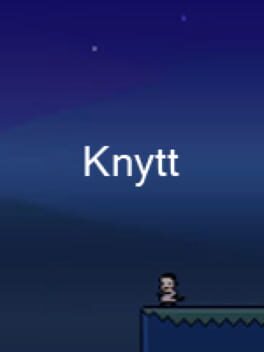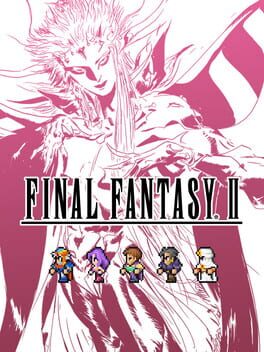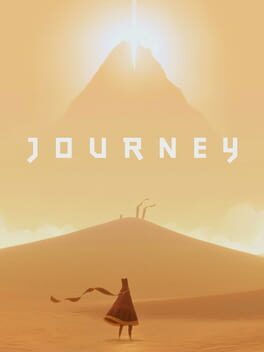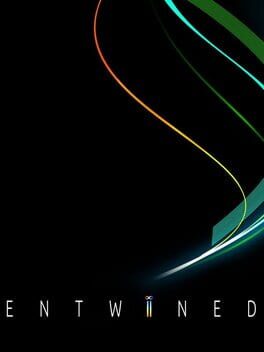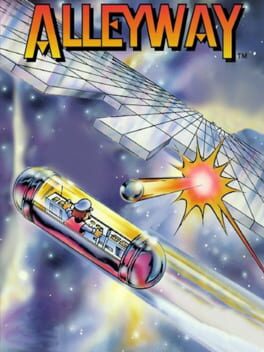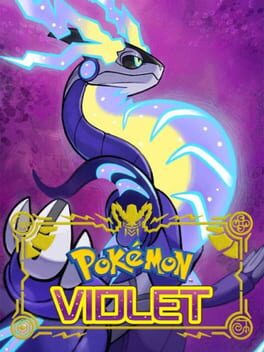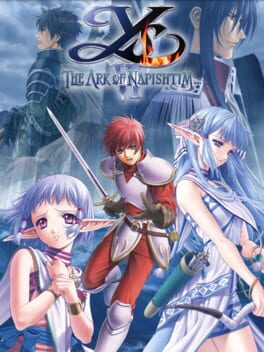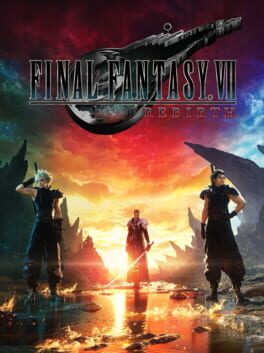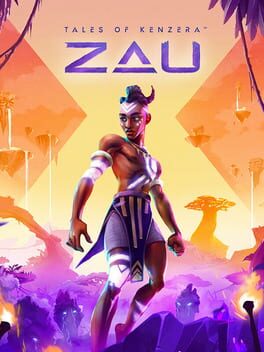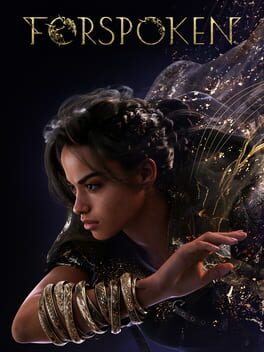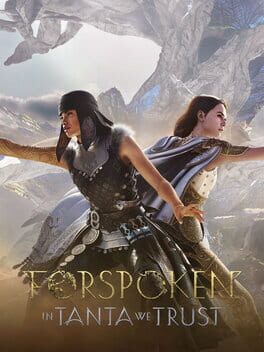tradegood
65 Reviews liked by tradegood
140
2013
Very stylish, short and simple game. The presentation here is really confident, big bold solid coloured geometric shapes, bars bouncing up and down in the background in time to the beats of the music.
You play as a little shapeshifting object, when stationary - a square. If you move horizontally you turn into a circle so it looks like you're rolling, and when you jump you become a triangle that rotates to meet the ground. There is no narrative or tutorial to speak of, the game teaches you through gradually introducing and layering simple concepts throughout the handful of levels.
As a level begins, there will be little to no ambient sound and your objective is to gather a nearby little circle filled with colour. The circle will be moving erratically and emitting quiet, tinny music of some sort. Once you "pick up" the circle, you take it to a clearly marked area and the colours inside spill out and repaint your whole world. The music they contained also becomes loud and deep, and suddenly a new mechanic begins to operate in the world allowing you to progress.
The levels all proceed in broadly this way, with generous checkpoints throughout, and build up to a sort of boss battle with a novel mechanic. The punishment for death is fairly minimal and there are only four levels. I'd say it's quite achieveable to finish the game in around an hour or two.
Beating a level also unlocks a "mirror" version of that same level. As you'd expect, the whole thing is completely mirrored and the colours are also inverted. To add another wrinkle, there are no checkpoints in this mode - each mirror world must be cleared without making any mistakes. It may be just me but I found this challenge particularly gruelling, especially levels 3 and 4. There were a few bits that I just couldn't quite nail down consistently, yet the majority of the time was spent repeating the same trivial sections. Due to being rhythm-based, attempting to listen to something else while playing was a recipe for disaster. I found myself in this awkward space where the game didn't require enough to be truly engaging, but required just enough focus that if my mind wandered too much I would immediately be punished. Still, the mirror mode is really just a bonus - so it's up to you whether you want to pursue it! I found it tougher than I thought I would but eventually did managed to beat all the mirror levels.
Overall, I like this game a fair amount. It's simple, effective and a good length. A great way to spend a quiet afternoon - but think hard before considering the mirror mode as a lot of the charm wears off in repeated playthroughs!
You play as a little shapeshifting object, when stationary - a square. If you move horizontally you turn into a circle so it looks like you're rolling, and when you jump you become a triangle that rotates to meet the ground. There is no narrative or tutorial to speak of, the game teaches you through gradually introducing and layering simple concepts throughout the handful of levels.
As a level begins, there will be little to no ambient sound and your objective is to gather a nearby little circle filled with colour. The circle will be moving erratically and emitting quiet, tinny music of some sort. Once you "pick up" the circle, you take it to a clearly marked area and the colours inside spill out and repaint your whole world. The music they contained also becomes loud and deep, and suddenly a new mechanic begins to operate in the world allowing you to progress.
The levels all proceed in broadly this way, with generous checkpoints throughout, and build up to a sort of boss battle with a novel mechanic. The punishment for death is fairly minimal and there are only four levels. I'd say it's quite achieveable to finish the game in around an hour or two.
Beating a level also unlocks a "mirror" version of that same level. As you'd expect, the whole thing is completely mirrored and the colours are also inverted. To add another wrinkle, there are no checkpoints in this mode - each mirror world must be cleared without making any mistakes. It may be just me but I found this challenge particularly gruelling, especially levels 3 and 4. There were a few bits that I just couldn't quite nail down consistently, yet the majority of the time was spent repeating the same trivial sections. Due to being rhythm-based, attempting to listen to something else while playing was a recipe for disaster. I found myself in this awkward space where the game didn't require enough to be truly engaging, but required just enough focus that if my mind wandered too much I would immediately be punished. Still, the mirror mode is really just a bonus - so it's up to you whether you want to pursue it! I found it tougher than I thought I would but eventually did managed to beat all the mirror levels.
Overall, I like this game a fair amount. It's simple, effective and a good length. A great way to spend a quiet afternoon - but think hard before considering the mirror mode as a lot of the charm wears off in repeated playthroughs!
Knytt
2006
i loved this.
a world full of unique critters and peoples,
a world with a lot of ambience,
a world with many simplistically beautiful scenes.
i initially felt like the walking speed should've been slower, so that you could take in that ambience without having to pause, but then i realized that this makes you feel more like a little guy quickly scurrying around, moving around everywhere faster than you can take it all in.
the ability to see where nearby items are was good, as it prevented the game from becoming annoying in the end.
i think i've realized that i really like simplistic platformers, and this was a wonderful example of one.
(i'm writing this at 11:47 pm, a few minutes after i finished playing the game, so i'm too tired to have well considered thoughts; forgive me)
a world full of unique critters and peoples,
a world with a lot of ambience,
a world with many simplistically beautiful scenes.
i initially felt like the walking speed should've been slower, so that you could take in that ambience without having to pause, but then i realized that this makes you feel more like a little guy quickly scurrying around, moving around everywhere faster than you can take it all in.
the ability to see where nearby items are was good, as it prevented the game from becoming annoying in the end.
i think i've realized that i really like simplistic platformers, and this was a wonderful example of one.
(i'm writing this at 11:47 pm, a few minutes after i finished playing the game, so i'm too tired to have well considered thoughts; forgive me)
Final Fantasy II
2021
Part 1: Introduction
About a month ago, I finished the first Final Fantasy for Famicom and kept my hopes up for FFII to see if it would improve on things that I didn’t care for in the first game. Despite my limited knowledge on the series, I was hiding something about it and that was the fact I have tried this game before. While there have been entries I have at least played a small bit before finishing FF1, this game was a special one.
Part 2: Hatefulness won’t leave me…
It all started a couple of years ago when I was struggling to get fan translations working. I told one of my oomfs at the time that as a joke I’d play FFII if I could get it patched correctly. It actually worked. If anyone is wondering how I was screwing up patching games into English, I was using the wrong emulator. So, I kept to my word and played through the game, realizing immediately why this game was hated off the bat. Even with my words, I barely got through the game, in fact I only played up to when you get Minwu which is like still almost the beginning of the game. This was all because I knew people in the US hated it and thought I should immediately join the hate, not even giving it a shot from a positive perspective. Now that I’ve played the first game, I have a better mindset and I like to think I improve with each year to come when looking at games. It was time to return.
Part 3: Returning with positives and failure
It was now time to start FFII on the Famicom for real. I went into it with a good first impression this time. The plot was more interesting this time and the party even have canon names and actual dialogue. There’s some stuff here like phoenix downs to revive the party and Chocobos that were introduced in this entry. The combat was actually interesting once I understood it, you level up like it’s a training arc in an anime. Or you know just real life training, god this shows how much of my life is gaming and anime. The music, oh god the music! It’s even better than before like even the way it begins it’s even better than how it sounded before! How did they do it?! The music in general captures the setting and tone so well. Best of all, there’s MP! Yes! No more spell charges!! This game is for sure better than the first game! How can it not? Well around a little over halfway, I kept dying and dying and got frustrated. Why was this happening? Why is it so hard I asked. It took me time to think about it but it was because my magic variety was so small, but I didn’t want to grind again just to stand a chance, it’s so tedious at times to raise your magic and eventually I gave up and quit the game. I felt sad about it but that’s just how life can be. I was going to write a review about my failures but before bed, I had a great idea. What about the Pixel Remaster?
Part 4: The actual version I finished
Now it was time to try this one out and I was blown away from the start. There’s more to the opening this time though you still have to lose that beginning fight which might be the first of its kind? Does anyone know of others? This remaster looks really nice and outside of a complaint I’ll talk about later, there really aren't any issues with them. You’ll start with three characters. The three are Firion, Maria, and Guy. There was a fourth one named Leon but more on him later. You can oddly still name them whatever you want despite not being silent like the warriors of light from FF1. It is cool that the three talk but sadly they don’t have much to say here. This is still 1988 so it’s fine with me. You’ll also realize the title is a lot more depressing as you’ll experience many deaths from minor NPCs to major characters, many calamities will occur like a race almost being extinct and even worse you won’t always be successful in your efforts showing that you’re not always the one ahead of the curve like in FF1. I don’t think it’s some amazing tearful tale but I felt it was more interesting than the first game. I also found it interesting how you can learn specific terms to ask certain characters to progress through the story or get hints but it's a very basic feeling. I do appreciate the remaster for at least now telling you what words work for a character at the current time.
The combat is rather odd in this one as you’ll have to manually up every weapon, magic, and stat for each of your characters. There is no EXP in this game and it’s a little crazy they made such a risky change for a sequel. Though this was more of the norm at the time to do something like this so it’s not too unusual. The nice thing about this remaster is the grind was toned down a ton. I’m not sure if this was a thing in previous remakes of the game but compared to the Famicom one, you’ll be saving hours. This also means you can experiment more. Your party has things they can be set up with from the start but they can be anything you want. Guy may look like the power character of the group but he can be your white mage if you so choose. You can even get wacky and do stuff you could never do in the original. You also still have to buy magic and this time there’s no stronger variants or magic due to this new leveling up system. It’s very manageable here meaning I got to use a lot of magic and have fun. It’s a very fun system depending on the version and patience you have to do it.
When it comes to progression, the difficulty is quite easy especially when you can up your stats better in this version. It also helps you have actual MP this time. No more spell charges here thank god and now you have way more opportunities to use magic here. There’s even MP restoring items but sadly the amount they give you is small and they’re kind of pricey in the early game to ever be helpful. The difficulty is really all on you for how you want to go through the game. If you really wanted, you can just do something silly like hit yourself and eventually have thousands of HP just for the fun of it. Knowing where to go is also not too bad and you shouldn’t get lost from my experience.
Then we got to the dungeons and oh boy, what happened here? Look I wasn’t the biggest fan of them in the first but they are worse here. Some are more interesting than others but because this game’s encounter rate can be a bit annoying it makes these places drag out. The worst part about them is the fact they love to have doors where they lead you into a rectangular room that has nothing and has a high encounter rate for tough enemies. It’s spammed throughout the game and rarely they can have items so you might wanna look through them all anyway. Easily the worst part about the game right there. They also got rid of enemy spawns on tiles so enemies you fight for treasures now activate as you open one, kind of like a Mimic from DQ. I also notice when you’re on those tiles that hurt you, you can’t spawn enemies but it always spawns a battle right after you get off one. It gave me this hilarious vision of you suffering on these tiles while you see an enemy with a wooden plank casually waiting for your painful arrival. Unknowing to him though I’m stronger than him anyway so I’m having the last laugh anyway OHOHOHOHO!!!
Some smaller stuff I could talk about like the music, omg I already liked how it sounded on Famicom, the orchestra is heavenly! Like I don’t know how you make stuff like the overworld map already sound better than it already did. Even by the very end with Pandaemonium it just wows me with the OST presented. Running away in this remaster feels a lot easier than in the original. I swear it feels impossible at times to run away in that game. I read it's suppose to work better if you have higher agility but it still feels very inconsistent in the Famicom version. I wish this game had more of the airship or a way you can use the Chocobo more. The Chocobo is in a forest south of the place you find Gordon and it can help you avoid encounters but it leaves the moment you dismount it. Would have liked a command or item to summon it anytime like in Final Fantasy Adventure. Though you can just turn encounters off in this remaster anyway which kind of makes him a little pointless. I also love the maps for the world and dungeons though you could see it as cheating to avoid dead ends. Really there’s just a lot in this remaster to enjoy and that wasn’t even all of it. Though I don't know if it was just me but there was constant stutters if I kept the game running after a little bit. I don't know why this happens.
Part 5: An end to the journey and review
I could probably say more but I don’t wanna drag out this review going over every bit and detail about the playthrough. I used to know this as the bad Final Fantasy but at the end of this playthrough, I thought it was very good. It’s not perfect and I can understand why some hate it but I don’t know, I just find stuff to appreciate in this one. This would be the only entry to really play like this though the eventual birth of the SaGa series would bring some of these mechanics back into there so I’ll probably check some of those someday. Now despite my experience with the Famicom version, I still think in a way it’s worth checking out just as an interesting history piece of something America almost got. Just remember that you’ll be grinding lots and I mean lots in that version. Otherwise the remaster is the way to go and plus it’s only $12 which is nice. Next time I’ll be ending the 8-bit trilogy with FFIII. I’m not sure yet if I’ll play the Famicom version of that one or not but odds are that I’ll try to play it. That’s the one that’s usually seen as the best of the three so I’m excited to try it sometime this year. Another adventure awaits for me, hopefully next time not as depressing as this one because god I don’t wanna see so many characters dying…
About a month ago, I finished the first Final Fantasy for Famicom and kept my hopes up for FFII to see if it would improve on things that I didn’t care for in the first game. Despite my limited knowledge on the series, I was hiding something about it and that was the fact I have tried this game before. While there have been entries I have at least played a small bit before finishing FF1, this game was a special one.
Part 2: Hatefulness won’t leave me…
It all started a couple of years ago when I was struggling to get fan translations working. I told one of my oomfs at the time that as a joke I’d play FFII if I could get it patched correctly. It actually worked. If anyone is wondering how I was screwing up patching games into English, I was using the wrong emulator. So, I kept to my word and played through the game, realizing immediately why this game was hated off the bat. Even with my words, I barely got through the game, in fact I only played up to when you get Minwu which is like still almost the beginning of the game. This was all because I knew people in the US hated it and thought I should immediately join the hate, not even giving it a shot from a positive perspective. Now that I’ve played the first game, I have a better mindset and I like to think I improve with each year to come when looking at games. It was time to return.
Part 3: Returning with positives and failure
It was now time to start FFII on the Famicom for real. I went into it with a good first impression this time. The plot was more interesting this time and the party even have canon names and actual dialogue. There’s some stuff here like phoenix downs to revive the party and Chocobos that were introduced in this entry. The combat was actually interesting once I understood it, you level up like it’s a training arc in an anime. Or you know just real life training, god this shows how much of my life is gaming and anime. The music, oh god the music! It’s even better than before like even the way it begins it’s even better than how it sounded before! How did they do it?! The music in general captures the setting and tone so well. Best of all, there’s MP! Yes! No more spell charges!! This game is for sure better than the first game! How can it not? Well around a little over halfway, I kept dying and dying and got frustrated. Why was this happening? Why is it so hard I asked. It took me time to think about it but it was because my magic variety was so small, but I didn’t want to grind again just to stand a chance, it’s so tedious at times to raise your magic and eventually I gave up and quit the game. I felt sad about it but that’s just how life can be. I was going to write a review about my failures but before bed, I had a great idea. What about the Pixel Remaster?
Part 4: The actual version I finished
Now it was time to try this one out and I was blown away from the start. There’s more to the opening this time though you still have to lose that beginning fight which might be the first of its kind? Does anyone know of others? This remaster looks really nice and outside of a complaint I’ll talk about later, there really aren't any issues with them. You’ll start with three characters. The three are Firion, Maria, and Guy. There was a fourth one named Leon but more on him later. You can oddly still name them whatever you want despite not being silent like the warriors of light from FF1. It is cool that the three talk but sadly they don’t have much to say here. This is still 1988 so it’s fine with me. You’ll also realize the title is a lot more depressing as you’ll experience many deaths from minor NPCs to major characters, many calamities will occur like a race almost being extinct and even worse you won’t always be successful in your efforts showing that you’re not always the one ahead of the curve like in FF1. I don’t think it’s some amazing tearful tale but I felt it was more interesting than the first game. I also found it interesting how you can learn specific terms to ask certain characters to progress through the story or get hints but it's a very basic feeling. I do appreciate the remaster for at least now telling you what words work for a character at the current time.
The combat is rather odd in this one as you’ll have to manually up every weapon, magic, and stat for each of your characters. There is no EXP in this game and it’s a little crazy they made such a risky change for a sequel. Though this was more of the norm at the time to do something like this so it’s not too unusual. The nice thing about this remaster is the grind was toned down a ton. I’m not sure if this was a thing in previous remakes of the game but compared to the Famicom one, you’ll be saving hours. This also means you can experiment more. Your party has things they can be set up with from the start but they can be anything you want. Guy may look like the power character of the group but he can be your white mage if you so choose. You can even get wacky and do stuff you could never do in the original. You also still have to buy magic and this time there’s no stronger variants or magic due to this new leveling up system. It’s very manageable here meaning I got to use a lot of magic and have fun. It’s a very fun system depending on the version and patience you have to do it.
When it comes to progression, the difficulty is quite easy especially when you can up your stats better in this version. It also helps you have actual MP this time. No more spell charges here thank god and now you have way more opportunities to use magic here. There’s even MP restoring items but sadly the amount they give you is small and they’re kind of pricey in the early game to ever be helpful. The difficulty is really all on you for how you want to go through the game. If you really wanted, you can just do something silly like hit yourself and eventually have thousands of HP just for the fun of it. Knowing where to go is also not too bad and you shouldn’t get lost from my experience.
Then we got to the dungeons and oh boy, what happened here? Look I wasn’t the biggest fan of them in the first but they are worse here. Some are more interesting than others but because this game’s encounter rate can be a bit annoying it makes these places drag out. The worst part about them is the fact they love to have doors where they lead you into a rectangular room that has nothing and has a high encounter rate for tough enemies. It’s spammed throughout the game and rarely they can have items so you might wanna look through them all anyway. Easily the worst part about the game right there. They also got rid of enemy spawns on tiles so enemies you fight for treasures now activate as you open one, kind of like a Mimic from DQ. I also notice when you’re on those tiles that hurt you, you can’t spawn enemies but it always spawns a battle right after you get off one. It gave me this hilarious vision of you suffering on these tiles while you see an enemy with a wooden plank casually waiting for your painful arrival. Unknowing to him though I’m stronger than him anyway so I’m having the last laugh anyway OHOHOHOHO!!!
Some smaller stuff I could talk about like the music, omg I already liked how it sounded on Famicom, the orchestra is heavenly! Like I don’t know how you make stuff like the overworld map already sound better than it already did. Even by the very end with Pandaemonium it just wows me with the OST presented. Running away in this remaster feels a lot easier than in the original. I swear it feels impossible at times to run away in that game. I read it's suppose to work better if you have higher agility but it still feels very inconsistent in the Famicom version. I wish this game had more of the airship or a way you can use the Chocobo more. The Chocobo is in a forest south of the place you find Gordon and it can help you avoid encounters but it leaves the moment you dismount it. Would have liked a command or item to summon it anytime like in Final Fantasy Adventure. Though you can just turn encounters off in this remaster anyway which kind of makes him a little pointless. I also love the maps for the world and dungeons though you could see it as cheating to avoid dead ends. Really there’s just a lot in this remaster to enjoy and that wasn’t even all of it. Though I don't know if it was just me but there was constant stutters if I kept the game running after a little bit. I don't know why this happens.
Part 5: An end to the journey and review
I could probably say more but I don’t wanna drag out this review going over every bit and detail about the playthrough. I used to know this as the bad Final Fantasy but at the end of this playthrough, I thought it was very good. It’s not perfect and I can understand why some hate it but I don’t know, I just find stuff to appreciate in this one. This would be the only entry to really play like this though the eventual birth of the SaGa series would bring some of these mechanics back into there so I’ll probably check some of those someday. Now despite my experience with the Famicom version, I still think in a way it’s worth checking out just as an interesting history piece of something America almost got. Just remember that you’ll be grinding lots and I mean lots in that version. Otherwise the remaster is the way to go and plus it’s only $12 which is nice. Next time I’ll be ending the 8-bit trilogy with FFIII. I’m not sure yet if I’ll play the Famicom version of that one or not but odds are that I’ll try to play it. That’s the one that’s usually seen as the best of the three so I’m excited to try it sometime this year. Another adventure awaits for me, hopefully next time not as depressing as this one because god I don’t wanna see so many characters dying…
Journey
2012
My enjoyment of Journey felt.... tenuous. There was a 20 minute stretch in the middle where no one else showed up and I thought to myself, "who cares about this shit at all, get me out" then 15 minutes later a stranger and I are spamming buttons to keep each other warm and I'm thinking to myself "I would die for you, comrade." I don't know. Cool game. What if no one else shows up though.
Entwined
2014
Alleyway
1989
Pokémon Violet
2022
Pokémon Violet
2022
Pokémon Violet is clearly unfinished and rushed in some parts - This may very well be the worst looking Switch game I ever played. It baffles me how we somehow ended up in a situation where a year after the last game, which looked and performed very badly, this one got released and looks and performs even worse. The extent of the technical problems is already well documented online, so let me just shift the focus for a minute here and say: I actually had a kinda fun time playing this?
I think that they discovered a way to make open-world Pokémon work for me: By just stuffing it full of new Pokémon. The world may be mostly empty, ugly, and featureless, but the new creatures - of which there are over 100 it seems - really aren't! Driving through this game's world and finding one new Pokémon after another was a really nice experience, actually. All those new designs to discover created an intrinsic motivation for me to explore these giant areas. Shifting the main focus away from just gym battles also helped in making the world feel a little more vast and diverse than it actually is. While none of the activities really stand out, they're all nice enough that I wanted to seek them out. I'm relieved the grind-based gameplay loop of Pokémon Legends Arceus is not a path they continued on further here.
So yea it's a nice lil´ game. Nothing especially great to find here, but the vibes and new Pokémon designs are really great. Were it not for the technical issues and rushed nature of some of the content in this game, I think this could've been a so-called "good video game™". In its current state Pokémon Violet is a game I quite like, despite it all.
I think that they discovered a way to make open-world Pokémon work for me: By just stuffing it full of new Pokémon. The world may be mostly empty, ugly, and featureless, but the new creatures - of which there are over 100 it seems - really aren't! Driving through this game's world and finding one new Pokémon after another was a really nice experience, actually. All those new designs to discover created an intrinsic motivation for me to explore these giant areas. Shifting the main focus away from just gym battles also helped in making the world feel a little more vast and diverse than it actually is. While none of the activities really stand out, they're all nice enough that I wanted to seek them out. I'm relieved the grind-based gameplay loop of Pokémon Legends Arceus is not a path they continued on further here.
So yea it's a nice lil´ game. Nothing especially great to find here, but the vibes and new Pokémon designs are really great. Were it not for the technical issues and rushed nature of some of the content in this game, I think this could've been a so-called "good video game™". In its current state Pokémon Violet is a game I quite like, despite it all.
There was no guarantee that it would turn out like this. After the one-two punch of the first two Ys games in 1987 and 1988, the series would take a number of perplexing turns through the late 80s and early 90s. Ys III, originally intended as a gaiden, was a side-scrolling platformer with only the barest hints of RPG elements. Then the two primary creative forces behind the first three Ys games, Tomoyoshi Miyazaki and Masaya Hashimoto, left to found Quintet before a proper sequel could be developed. Unable to deliver a full game on its own, Nihon Falcom provided a scenario and music for two versions of Ys IV, both released in 1993: Tonkin House’s abysmal Mask of the Sun for Super Famicom, and Hudon’s Dawn of Ys for PC Engine CD-ROM², a highly-polished follow-up to the superlative PC Engine CD-ROM² ports of the first two games. Both versions of Ys IV strive to recreate the gameplay and style of the first two Ys games, but neither has a clue about how to evolve Ys beyond the basic bump combat that was growing stale by 1993.
The real death blow to the series, though, was 1995’s Ys V: Lost Kefin, Kingdom of Sand, a late Super Famicom release developed by Falcom that makes the first real stab at defining the future of the series. Ditching bump combat in favor of dedicated attack and jump buttons, Ys V plays a lot like a Quintet game, except it lacks the elegant construction and polish of games such as Illusion of Gaia and Terranigma. While it's a memorable adventure with many of Falcom’s classic touches (the soundtrack whips), it’s clearly rushed. The difficulty is wildly uneven, the attempts at platforming fall flat, and technical issues such as loading times reveal Falcom’s lack of expertise working with the Super Famicom hardware. It’s not a bad action-RPG, but it’s not Ys.
The only signs of Ys’s continued survival as a series for the rest of the 90s were well-received remakes of Ys I and II. This is where the story could have ended. Ys could have gone the way of Hydlide or any number of the other influential Japanese role-playing series that couldn’t keep up with the times. Even Falcom itself, by this point reduced to subsisting primarily on low-budget Windows games, seemed headed for a similar fate as its 80s Japanese microcomputer contemporaries. But instead we got Ys VI, the beginning of a remarkable second life not just for Ys but for Falcom as a whole.
After being sucked into the Great Vortex, a thinly veiled version of the Bermuda Triangle, Adol finds himself on the Canaan Islands, a thinly veiled pastiche of a Caribbean island chain dominated by the tension between its native peoples (the Rehda) and largely European colonizers (the Eresians). While the overarching story itself is no great shakes, Falcom’s gift for applying the sweeping grandeur of mythological fantasy bullshit to small-scale settings shines through.
There are only two small towns and a handful of other NPCs, but every character has a name, a character portrait, a personality, and even their own ongoing arcs. The little dramas that play out, from the town drunk turning a new leaf to the two siblings running rival shops, lend the game its heart. Perhaps the strongest of these threads is how the Eresians, largely trapped on the islands by the Great Vortex against their will, have learned to live on the islands. Some have embraced their fate, while others are haunted by it.
Doubling down on Ys V’s more traditional action-RPG mechanics, Ys VI’s combat is built around attack and jump buttons along with a very basic magic system. While it adds some new twists such as leveling up your three elemental swords, it’s surprisingly close to a highly refined version of Ys V’s combat. Unlike Ys V though, Ys VI’s combat is blazingly fast and fluid. It’s closer to a beat ’em up than the stiff action-RPGs of the 16-bit era, with Adol bouncing around against hordes of enemies who occasionally bombard him with danmaku-esque projectile patterns. On normal difficulty, the curve is just right, encouraging a mix of grinding and dexterity, but never rising to frustration.
While there are only a handful of dungeons, they’re all intricate mazes that are deeply satisfying to explore, although nothing here matches the scope and ambition of Darm Tower or Solomon Shrine. The game is on the short side, but highly replayable, with multiple difficulty levels and an optional Catastrophe mode that removes healing items. As with the best of the earlier Ys games, it’s closer to a Metroidvania than a traditional RPG. There’s no overworld, and the two islands that comprise the vast majority of the game can be traversed end-to-end in just a few minutes.
Despite its many highs, Ys VI stumbles in a few places. Pacing is uneven, with an extended exposition drop at the end of the second act in particular killing the momentum for no real payoff. Platforming is unnecessarily fussy, with a counterintuitive long jump mechanic that’s sure to annoy. These flaws pull the game down from all-timer status, but this is still a must-play for fans of Ys and Falcom. A number of key players in the company’s ongoing renaissance, including future president Toshihiro Kondo, worked on the game, and it’s a joy to see them begin to figure out the future Falcom style here. That isn’t even getting into the superb artwork or the spectacular soundtrack, which blends the style of classic Ys music, Ryo Yonemitsu’s beloved Redbook audio arrangements from the PC Engine CD-ROM² games, and modern touches such as drum’n’bass breaks. I already can’t wait to pick this one up again for a Nightmare mode run.
The real death blow to the series, though, was 1995’s Ys V: Lost Kefin, Kingdom of Sand, a late Super Famicom release developed by Falcom that makes the first real stab at defining the future of the series. Ditching bump combat in favor of dedicated attack and jump buttons, Ys V plays a lot like a Quintet game, except it lacks the elegant construction and polish of games such as Illusion of Gaia and Terranigma. While it's a memorable adventure with many of Falcom’s classic touches (the soundtrack whips), it’s clearly rushed. The difficulty is wildly uneven, the attempts at platforming fall flat, and technical issues such as loading times reveal Falcom’s lack of expertise working with the Super Famicom hardware. It’s not a bad action-RPG, but it’s not Ys.
The only signs of Ys’s continued survival as a series for the rest of the 90s were well-received remakes of Ys I and II. This is where the story could have ended. Ys could have gone the way of Hydlide or any number of the other influential Japanese role-playing series that couldn’t keep up with the times. Even Falcom itself, by this point reduced to subsisting primarily on low-budget Windows games, seemed headed for a similar fate as its 80s Japanese microcomputer contemporaries. But instead we got Ys VI, the beginning of a remarkable second life not just for Ys but for Falcom as a whole.
After being sucked into the Great Vortex, a thinly veiled version of the Bermuda Triangle, Adol finds himself on the Canaan Islands, a thinly veiled pastiche of a Caribbean island chain dominated by the tension between its native peoples (the Rehda) and largely European colonizers (the Eresians). While the overarching story itself is no great shakes, Falcom’s gift for applying the sweeping grandeur of mythological fantasy bullshit to small-scale settings shines through.
There are only two small towns and a handful of other NPCs, but every character has a name, a character portrait, a personality, and even their own ongoing arcs. The little dramas that play out, from the town drunk turning a new leaf to the two siblings running rival shops, lend the game its heart. Perhaps the strongest of these threads is how the Eresians, largely trapped on the islands by the Great Vortex against their will, have learned to live on the islands. Some have embraced their fate, while others are haunted by it.
Doubling down on Ys V’s more traditional action-RPG mechanics, Ys VI’s combat is built around attack and jump buttons along with a very basic magic system. While it adds some new twists such as leveling up your three elemental swords, it’s surprisingly close to a highly refined version of Ys V’s combat. Unlike Ys V though, Ys VI’s combat is blazingly fast and fluid. It’s closer to a beat ’em up than the stiff action-RPGs of the 16-bit era, with Adol bouncing around against hordes of enemies who occasionally bombard him with danmaku-esque projectile patterns. On normal difficulty, the curve is just right, encouraging a mix of grinding and dexterity, but never rising to frustration.
While there are only a handful of dungeons, they’re all intricate mazes that are deeply satisfying to explore, although nothing here matches the scope and ambition of Darm Tower or Solomon Shrine. The game is on the short side, but highly replayable, with multiple difficulty levels and an optional Catastrophe mode that removes healing items. As with the best of the earlier Ys games, it’s closer to a Metroidvania than a traditional RPG. There’s no overworld, and the two islands that comprise the vast majority of the game can be traversed end-to-end in just a few minutes.
Despite its many highs, Ys VI stumbles in a few places. Pacing is uneven, with an extended exposition drop at the end of the second act in particular killing the momentum for no real payoff. Platforming is unnecessarily fussy, with a counterintuitive long jump mechanic that’s sure to annoy. These flaws pull the game down from all-timer status, but this is still a must-play for fans of Ys and Falcom. A number of key players in the company’s ongoing renaissance, including future president Toshihiro Kondo, worked on the game, and it’s a joy to see them begin to figure out the future Falcom style here. That isn’t even getting into the superb artwork or the spectacular soundtrack, which blends the style of classic Ys music, Ryo Yonemitsu’s beloved Redbook audio arrangements from the PC Engine CD-ROM² games, and modern touches such as drum’n’bass breaks. I already can’t wait to pick this one up again for a Nightmare mode run.
I haven't really stopped thinking about FFVII Rebirth since I finished it almost two months ago. It's an incredible game and a stunning accomplishment for its development team that somehow manages to both conform to and subvert expectations almost simultaneously
Its open world design feels very Ubisoft on the surface (or perhaps more directly, Horizon Zero Dawn), but more than that I found myself thinking as I played it that this is where Final Fantasy games must have gone in a parallel universe where capturing the feeling of the "world map" remained a priority beyond the era of the original PlayStation. In contrast to other modern open world games, Rebirth endeavors to (and succeeds in) making its open-world content rewarding, particularly with how character-focused many of its side-quests are
Like Remake before it, Rebirth is crafted with such love and reverence for the original Final Fantasy VII that it almost defies belief. More than once during my time with Rebirth, I uncovered remembrances of the original, drawn from the aether of the patchwork memory of my adolescence in vivid, almost overpowering detail
This is accompanied by the same sense of...playfulness that was so central to the original game: mini-games and over-the-top set-pieces abound, juxtaposed against the same compelling character work that so strongly elevated Rebirth's predecessor. Here, with the groundwork laid in Remake, the characters are explore in greater depth, with a particular focus on their relationships to one another and the world around them, culminating in the famous "Gold Saucer date" from the original, this time expanded into a full-blown opera house-style spectacle in true Final Fantasy fashion
While the ending will likely frustrate those still hoping for an entirely faithful retelling of Final Fantasy VII, it sets up a number of intriguing possibilities for the final installment of the Remake trilogy, and I firmly believe there's potential for many of the original story's strongest moments to land with more impact in 2027 than they did even all the way back in 1997
That is, of course, assuming the team sticks the landing, but from where I sit today, I have significant confidence that they will
Its open world design feels very Ubisoft on the surface (or perhaps more directly, Horizon Zero Dawn), but more than that I found myself thinking as I played it that this is where Final Fantasy games must have gone in a parallel universe where capturing the feeling of the "world map" remained a priority beyond the era of the original PlayStation. In contrast to other modern open world games, Rebirth endeavors to (and succeeds in) making its open-world content rewarding, particularly with how character-focused many of its side-quests are
Like Remake before it, Rebirth is crafted with such love and reverence for the original Final Fantasy VII that it almost defies belief. More than once during my time with Rebirth, I uncovered remembrances of the original, drawn from the aether of the patchwork memory of my adolescence in vivid, almost overpowering detail
This is accompanied by the same sense of...playfulness that was so central to the original game: mini-games and over-the-top set-pieces abound, juxtaposed against the same compelling character work that so strongly elevated Rebirth's predecessor. Here, with the groundwork laid in Remake, the characters are explore in greater depth, with a particular focus on their relationships to one another and the world around them, culminating in the famous "Gold Saucer date" from the original, this time expanded into a full-blown opera house-style spectacle in true Final Fantasy fashion
While the ending will likely frustrate those still hoping for an entirely faithful retelling of Final Fantasy VII, it sets up a number of intriguing possibilities for the final installment of the Remake trilogy, and I firmly believe there's potential for many of the original story's strongest moments to land with more impact in 2027 than they did even all the way back in 1997
That is, of course, assuming the team sticks the landing, but from where I sit today, I have significant confidence that they will
Forspoken
2023
This review contains spoilers
All cards on the table, I recognize this game's many faults. It's got shaky performance even after a lot of updates, a pretty obvious twist, a black protagonist with no black writers and a lot of other little issues that build up.
...but when it works? It really, really works. Traversal is snappy, quick, tasty with lots of options to keep even walking straight forward from being boring and average. Mechanically its dense with a system that takes a lot to get used to and it rewards you for getting used to it with some surprisingly interesting interactions that you can play on to do some surprisingly complex stuff. The character writing, while not amazing all the time, can be genuinely interesting and Cuff has an astounding presence as a villain with some of the greatest VA work I've heard in a modern video game. It's eternally a shame to me that people wrote this off and now this studio's gone because it genuinely deserves a sequel to iron out the kinks. This game reminds me of the PS2, man. It doesn't feel like a cynical, every day open world game, it felt like it was made by someone with a serious vision. Down to the magic system itself which isn't just procedurally generated physics engine pushing tech demo shit but these outstandingly particularly organized pops of elemental graffiti that create gorgeous murals when weaved together.
Genuine sleeper hit, man. I expect this game to get a reevaluation in 5 years.
...but when it works? It really, really works. Traversal is snappy, quick, tasty with lots of options to keep even walking straight forward from being boring and average. Mechanically its dense with a system that takes a lot to get used to and it rewards you for getting used to it with some surprisingly interesting interactions that you can play on to do some surprisingly complex stuff. The character writing, while not amazing all the time, can be genuinely interesting and Cuff has an astounding presence as a villain with some of the greatest VA work I've heard in a modern video game. It's eternally a shame to me that people wrote this off and now this studio's gone because it genuinely deserves a sequel to iron out the kinks. This game reminds me of the PS2, man. It doesn't feel like a cynical, every day open world game, it felt like it was made by someone with a serious vision. Down to the magic system itself which isn't just procedurally generated physics engine pushing tech demo shit but these outstandingly particularly organized pops of elemental graffiti that create gorgeous murals when weaved together.
Genuine sleeper hit, man. I expect this game to get a reevaluation in 5 years.
Forspoken
2023
This review contains spoilers
Forspoken is like Twilight in that there's a lot of serious, legitimate complaints about it, but they're all overshadowed in mainstream discourse by people hating it because the lead is a teenage girl.
Legitimate criticisms:
• SE has the worst fucking marketing department in the world. Not just this game, they have been so bad at marketing literally every game over the past few years. They picked by far the worst dialogue in the game for that trailer and didn't include anything from the first 20 min, which is far more interesting?! Also, the trailer made the game seem super PG when this is an M-rated game and the intro is dour and gritty?! Most of the game takes itself very seriously and Fray is serious and mature in a lot of scenes, the banter stuff is mostly just when it's her and Cuff alone and I actually didn't think it felt grating or cringe.
• This is a story about a black woman in NYC who is an orphan and a repeat offender, who avoids major jail time because the black woman judge decides to give her a second chance. This is explicitly a story about American blackness, but they didn't have a single black writer working on the game. I like that premise for an isekai and there are a lot of interesting possibilities there, but an affluent white writer is absolutely not the right person to tell that story!
• The "twist" and ending are infuriating because you can tell the writers think they're so fucking clever, but it's obvious, cliche, and dodges all of the difficult and interesting aspects of the story to do a boring "The power was within you all along" happy ending. Things not addressed: Tanta Cinta thought New York City in 2001 was the most peaceful and wonderful place on earth? And nothing happened around then to change that perspective? Frey's dad didn't take care of her and didn't have any friends/family to take care of her either? Is that because he died in 9/11 around the same time the corruption started in Athia?! If the premise for your game is that this fantasy apocalypse happened at the same time as 9/11, why don't you address that?!
• Reading the archive entries after the fact, they directly tell you that the Rheddig invaded Athia and found Susurrus, a demon defeated by the first Tanta, locked away in the Locked Labyrinths and considered him a hidden super weapon, so they freed him as they were retreating after losing the war. That's an interesting and reasonable story and it's fitting that Frey has to seal Susurrus away again, like the first Tanta did, and like the 4 Tantas were unable to do. However, in the dialogue in the story quests, the Tantas say they started the war with the Rheddig (no reason given) and wiped them from the face of the Earth and then Susurrus implies he's the last of the Rheddig and doing this to get revenge for them? What the fuck?! You absolutely cannot say that the victims of ethnic cleansing are in the wrong in your story!!! Why is there such a huge disconnect between these two things?! The first makes Frey wearing Cuff again seem like a fun "Devil on your shoulder" frenemies thing (which is the tone they want for him), but the second feels like you're enslaving the last person of the race your mom genocided, which is extremely fucked up.
Gameplay:
• The magic parkour feels like Jet Set Radio Fantasy, which makes me wish Cuff was more like Professor K.
• The combat clicked for me when I encountered a horde of 20-30 zombies. There were so many of them that the AOE and crowd control aspects of the spells really shone.
• The combat and movement absolutely rule once you get a feel for it. Circle-strafing enemies and holding O to automatically dodge attacks feels so good when you're cartwheeling through the air while shooting a machine gun behind your back. Cycling through spells to put them all on cooldown makes me feel really cool and smart, even though it's not that complex to do and I'm not using that much strategy.
Legitimate criticisms:
• SE has the worst fucking marketing department in the world. Not just this game, they have been so bad at marketing literally every game over the past few years. They picked by far the worst dialogue in the game for that trailer and didn't include anything from the first 20 min, which is far more interesting?! Also, the trailer made the game seem super PG when this is an M-rated game and the intro is dour and gritty?! Most of the game takes itself very seriously and Fray is serious and mature in a lot of scenes, the banter stuff is mostly just when it's her and Cuff alone and I actually didn't think it felt grating or cringe.
• This is a story about a black woman in NYC who is an orphan and a repeat offender, who avoids major jail time because the black woman judge decides to give her a second chance. This is explicitly a story about American blackness, but they didn't have a single black writer working on the game. I like that premise for an isekai and there are a lot of interesting possibilities there, but an affluent white writer is absolutely not the right person to tell that story!
• The "twist" and ending are infuriating because you can tell the writers think they're so fucking clever, but it's obvious, cliche, and dodges all of the difficult and interesting aspects of the story to do a boring "The power was within you all along" happy ending. Things not addressed: Tanta Cinta thought New York City in 2001 was the most peaceful and wonderful place on earth? And nothing happened around then to change that perspective? Frey's dad didn't take care of her and didn't have any friends/family to take care of her either? Is that because he died in 9/11 around the same time the corruption started in Athia?! If the premise for your game is that this fantasy apocalypse happened at the same time as 9/11, why don't you address that?!
• Reading the archive entries after the fact, they directly tell you that the Rheddig invaded Athia and found Susurrus, a demon defeated by the first Tanta, locked away in the Locked Labyrinths and considered him a hidden super weapon, so they freed him as they were retreating after losing the war. That's an interesting and reasonable story and it's fitting that Frey has to seal Susurrus away again, like the first Tanta did, and like the 4 Tantas were unable to do. However, in the dialogue in the story quests, the Tantas say they started the war with the Rheddig (no reason given) and wiped them from the face of the Earth and then Susurrus implies he's the last of the Rheddig and doing this to get revenge for them? What the fuck?! You absolutely cannot say that the victims of ethnic cleansing are in the wrong in your story!!! Why is there such a huge disconnect between these two things?! The first makes Frey wearing Cuff again seem like a fun "Devil on your shoulder" frenemies thing (which is the tone they want for him), but the second feels like you're enslaving the last person of the race your mom genocided, which is extremely fucked up.
Gameplay:
• The magic parkour feels like Jet Set Radio Fantasy, which makes me wish Cuff was more like Professor K.
• The combat clicked for me when I encountered a horde of 20-30 zombies. There were so many of them that the AOE and crowd control aspects of the spells really shone.
• The combat and movement absolutely rule once you get a feel for it. Circle-strafing enemies and holding O to automatically dodge attacks feels so good when you're cartwheeling through the air while shooting a machine gun behind your back. Cycling through spells to put them all on cooldown makes me feel really cool and smart, even though it's not that complex to do and I'm not using that much strategy.
In Tanta We Trust is fantastic in how it improves on the base game. By narrowing the focus to one area from the base game and highlighting two specific characters, it allows the developers to craft an even more compelling narrative. You are confined in one region in Visoria, where a new villain is ransacking the town and it is up to you to stop them.
What really works for this outing is that, while the DLC is condensed in nature, it doesn't feel that way. It starts off somewhat linear but opens up and you are able to traverse the area in an open world fashion just like the base game. It is confined to a specific area but there are several sub quests and points of interest that you can deal with in order to get more out of the game. I clocked in around 4 hours of total gameplay and that's pretty good considering I bout the DLC on sale for around $5.
Because of the focused narrative and smaller area, the developers were able to craft a more compelling narrative with vastly improved cutscenes. These felt movie quality at times and blew me away with how detailed and expressive they were. The characters are even more interesting, adding new layers to the previous story, and the villain is not only cool but also interesting throughout.
They were able to make a faction that was pretty dang evil in the base game, rather understandable by the end. There is a twist that I won't spoil that had me reevaluating the entire base game and that takes talent. In addition, the new powers and abilities are cool, while the gameplay shifts slightly to introduce this co-op fighting mechanic between the two characters that I found compelling. It is still single player but you control both characters movesets and they made it work really well. If you have finished Forspoken, give this a playthrough because it improves in just about every way, with fantastically epic boss fights and monsters that are supremely clever and showcase the talent of the developers. It really makes me want a sequel by the end.
What really works for this outing is that, while the DLC is condensed in nature, it doesn't feel that way. It starts off somewhat linear but opens up and you are able to traverse the area in an open world fashion just like the base game. It is confined to a specific area but there are several sub quests and points of interest that you can deal with in order to get more out of the game. I clocked in around 4 hours of total gameplay and that's pretty good considering I bout the DLC on sale for around $5.
Because of the focused narrative and smaller area, the developers were able to craft a more compelling narrative with vastly improved cutscenes. These felt movie quality at times and blew me away with how detailed and expressive they were. The characters are even more interesting, adding new layers to the previous story, and the villain is not only cool but also interesting throughout.
They were able to make a faction that was pretty dang evil in the base game, rather understandable by the end. There is a twist that I won't spoil that had me reevaluating the entire base game and that takes talent. In addition, the new powers and abilities are cool, while the gameplay shifts slightly to introduce this co-op fighting mechanic between the two characters that I found compelling. It is still single player but you control both characters movesets and they made it work really well. If you have finished Forspoken, give this a playthrough because it improves in just about every way, with fantastically epic boss fights and monsters that are supremely clever and showcase the talent of the developers. It really makes me want a sequel by the end.
Forspoken
2023
Forspoken is a game that gripped me from the teaser I saw at E3. The style and visual flair alone had me hooked without knowing much about the game, along with the fact that the main character was a young woman and had a cat. At the time of release, the game was lambasted by many people, but these people only cited some dialogue from the game and nothing else. I ended up picking up the game on sale and started playing a year after release.
While the introduction to the game is a bit clunky in terms of gameplay and the story is a tad slow to start, overall this ended up being a fantastic experience. The characters are deep and compelling with reasons for what they are doing. They have character flaws but they are powerful and at the end of the day I highly enjoyed them. The story tackles deep subject matter such as dementia, abandonment, and self-loathing. The gameplay grows over time into something that is just so satisfying to play.
Forspoken to me is the next iteration of the InFamous formula and it works. It's been years since InFamous Second Son and First Light, so Forspoken is here to fill the gaps and I think it does so admirably.
While the introduction to the game is a bit clunky in terms of gameplay and the story is a tad slow to start, overall this ended up being a fantastic experience. The characters are deep and compelling with reasons for what they are doing. They have character flaws but they are powerful and at the end of the day I highly enjoyed them. The story tackles deep subject matter such as dementia, abandonment, and self-loathing. The gameplay grows over time into something that is just so satisfying to play.
Forspoken to me is the next iteration of the InFamous formula and it works. It's been years since InFamous Second Son and First Light, so Forspoken is here to fill the gaps and I think it does so admirably.

